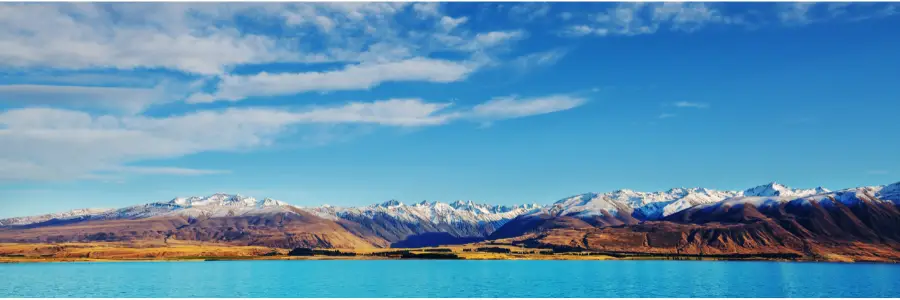Fancy a winter visit to New Zealand to ski and check out the fantastic winter scenery, but not sure when that is?
Winter in New Zealand happens mid-year, officially from June to August. The first day of June is the most commonly recognized start of winter. After the shortest day (winter solstice), cold temperatures intensify for the next 3-4 months before spring brings warmer weather.
As a small, narrow landmass in the south Pacific Ocean, prevailing weather systems influence the winter climate with varying temperatures from north to south.
Sunshine, wind, rain and snow can all happen in one day. It’s also not uncommon for the country’s north to bask in warming sunshine while the south is experiencing a sub-Antarctic blast.
This may help you decide the best time to plan your visit.
What are the winter months in NZ?
While the official winter months are June, July and August, the winter months extend from June through to October.
Winter temperatures across New Zealand average (45°F) 7.2°C and (60.1°F) 15.6°C in the lowlands.
New Zealand has a temperate climate. (A temperate climate means moderate rainfall, mild to warm summers and cool to cold winters.)
New Zealand sits in the southern hemisphere, located deep in the south Pacific Ocean at 41º South 174º East.
The country is exposed to the southern ocean blasts from the Antarctic, bringing driving wind, rain and snow and cooler conditions.
Because it is closer to the Antarctic, the South Island is colder than the North Island, and is home to the majority of winter snow sports.
In contrast, during the summer months, you can spend days in a T-shirt and shorts while carrying a light jacket in the sunniest areas, like the Bay of Islands, Hawkes Bay and Nelson.
Fun Fact Schools and many businesses close over Christmas and into January, making it a great time of year for family holidays. During this time, New Zealanders families get out camping at the many gorgeous beaches over these long hot days.
What marks New Zealand’s winter weather?
As an island nation in the middle of a large ocean, New Zealand is exposed to strong winds, rain and snow in the winter.
The prevailing weather from the Antarctic polar region brings freezing conditions and cooler winter temperatures.
This results in excellent skiing conditions in the high mountain ranges, the Southern Alps of the South Island, and the volcanic mountain peaks on the central plateau of the North Island.
But because the two islands are long and narrow, the climate can change instantly.
A sunny day can quickly deteriorate into a freezing southerly blast.
As a result, all those involved in various other outdoor activities must carry warm and waterproof clothing, even on day trips.
Rather visit New Zealand in the summer? Here’s why summer is a great time to visit.
What do New Zealanders do in winter?
Aside from skiing, New Zealanders enjoy winter sports like rugby union and rugby league, football, and netball.
Outdoor lifestyles continue over winter, minus the beach and swimming.
There are fabulous landscapes and beautiful vistas to visit, created by the stunning mountain ranges covered in snow.

Popular tourist activities include bungee jumping, horseback riding, jet boat rides and white water rafting, and hiking in native forests.
If you’d rather stay indoors, there are many wineries, cafes and restaurants.
With little air pollution, New Zealanders get abundant sunshine with stunning clear skies on many days, though it can be windy.
Is New Zealand cold in winter?
New Zealand’s temperatures range widely. The far north is subtropical, while the far south can be almost sub-Antarctic at times.
For instance, in July, the average winter temperature in the far north of the North Island is 59° F (15° C).
(The most northern region is commonly known as the “winterless north” due to its subtropical climate.)
In contrast, the average winter temperature in the far south of the South Island is 43° F (6° C).
However, extremely low temperatures don’t extend for days on end.
For example, a cold winter’s day is 43° F (6° C), with overnight temperatures falling below 32° F (0° C). But the thermometer does not generally stay below freezing during daylight hours.
That’s because of two things. Firstly, New Zealand does not have a large internal landmass.
Secondly, it is surrounded by water. Both these factors moderate the harsh highs and lows.
Accordingly, snow falls in the mountainous areas, but there are few snowfalls in the major cities which are located primarily in coastal areas.
Fun Fact Milford Sound is the wettest inhabited place in New Zealand and one of the wettest places on earth, with an average of 182 rainy days per year.
Does New Zealand have snow all year round?
Snow rarely lays on the ground all year round.
In the mountainous areas where the ski fields are located, snow falls during the winter months.
But the snow will usually melt, leaving the mountainous ranges bare during summer.
The high-country inland alpine areas of the South Island are often the last locations to lose their snow.
Learn about New Zealand’s amazing flightless birds.
When to come to New Zealand for skiing
Snow-based tourism is seasonal in New Zealand, falling from June to October.
Many skiers will come to enjoy New Zealand’s colder weather while the northern hemisphere is experiencing the summer months.
There are some spectacular ski fields and many other winter activities.
The town of Queenstown, which is located in the Southern Alps, has an international reputation as an ideal winter destination.
The scenery is stunning and there is good access to great ski fields.
Hope to see you here in New Zealand one day soon.
